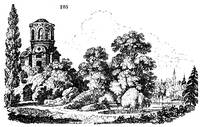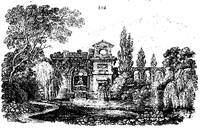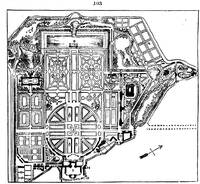355. The gardens at Schwezingen (fig. 103.), between the Rhine and the Main, belonging to the Grand Duke, are considered by Kraft as the most delightful in Germany. They cover a surface of about 300 acres, and contain the ancient castle of the Marquises of Baden (1). 'The marquisate of Baden,' says Kraft, 'having progressively and considerably increased by means of a numerous family, wings were obliged to be built on each side, divided into apartments. The hothouses, which form the wings (2, 2), have been much increased. In front, and more advanced, is the garden, in the French style, executed on a circular plan. In the middle of the avenue are four grass-plots, bordered and enamelled with flowers. In the middle are little basins with fountains, one of which (3) throws the water sixty-seven feet high. On the right and left are plantations of orange trees and odoriferous shrubs, interspersed with statues and vases of the finest marble. Farther on are discovered the gardens, called the groves, situated on the right and left, laid out in different forms, and embellished with a number of sculptures, vases, statues, the temple of Minerva (4), the great rock, surmounted by a figure of Pan (5), and Venus bathing (6).; Higher up is the garden of the large grove, ornamented with numerous figures (7 7 7 7), altars, tombs, urns, &c. Shady walks lead to the great basin (8), the gates leading to which have groups of figures on the pedestals (9,9). The Grand Duke reserves the grand basin for the amusement of his family pour des petites navigations. A very magnificent Turkish mosque (10) is erected on the left. Here begins the picturesque garden, with artificial hills, vales, and slopes; many different sorts of trees; a temple of Mercury in ruins (11); and various walks, leading through shrubberies to the right, till you arrive at the nursery garden (12). From thence, crossing the canal, you arrive at the temple of Apollo (13), built of costly marble. In the garden behind are rocks with allegorical figures, subterraneous caves and caverns; at one side a family bath of marble (14), aviaries (15), cabinets, pleasure-garden, and basin for aquatic fowls (16 and 17); small buildings, in the form of monuments (18), serving as cabinets of natural history, museums, a laboratory, &c.; a picturesque garden and temple (19); a Roman aqueduct (20), supplied by a water-engine (21); a ruined aqueduct (22); the office for the administration of the garden, with its appurtenances (23); a large theatre (24); the residence of the director-general (25); of the inspectors of the garden (26); of the inspectors of the forest (27); of the huntsmen (28); of the foresters (29). Besides all these things, and many more, there is a fruit-garden (30); a kitchen-garden (31); a private orangery (32); an area for greenhouse plants in summer (33); and a lofty water-engine for conveying water to the castle (34). The gardens of Schwezingen the author of An Autumn near the Rhine agrees with Kraft in considering the most splendid in Germany. 'The palace is a desolate building, without any traces of magnificence. The entry into the gardens, through the archway of the palace, is very striking. The stately alleys of times long past; the broad gravel terraces, the parterres, the fountains, and the statues, present an array of pompous formality, without destroying its magnificence. In their peculiar style, which is French, and formal, it would be difficult to suggest any improvements on the good taste and splendour of these gardens. Every thing is upon a grand scale. The classical temples, and the fine marble statues, have nothing trumpery or mesquin in their appearance, but are really such as one might imagine adorning a sequestered grove near the Tiber, instead of the Rhine. Even the Pan playing his syrinx (a flute with seven reeds) on a dripping rock, at the end of a cool grassy alley, is so well executed and placed, that an Arcadian dream could not be better embodied. You only wish the �'Satyrs and sylvan boys were seen, Peeping from out their alleys green,' to make it complete. The temple of Apollo is the most beautiful of the many ornaments of these grounds. In following one of the walks in the thick wilderness, which covers the sides of the garden, and happily conceals its limits, you come to an open grassy space enclosed by thick shrubs. In the middle is a large turf basin, adorned with sphinxes; on the other side of which you are struck by a light, graceful, open temple, on a rocky elevation, with the statue of the god in the middle, and the clear sky and the grove beyond appearing through it. The effect is classical and beautiful. Against the rock, under the temple, two naiads of white Carrara marble recline, pouring from an urn a stream which flows down a cascade of steps into a basin. On each side of the cascade, steps lead up to the temple, the round dome of which is supported by simple Ionic pillars. From the temple you look on all sides, into the thick green wilderness. On the last visit of the Emperor of Russia and the King of Prussia to the Grand Duke of Baden, a play was represented on this spot in the open air: the great basin, now empty, was converted into the pit, with benches for the illustrious guests, and a stage was erected in front of the temple. The whole grove was brilliantly illuminated, and the effect was described as highly beautiful. It is unnecessary to particularise the many other temples, baths, ruins, fountains, obelisks, &c., which embellish the gardens. One of the most curious is the Turkish mosque; an elaborate imitation of an oriental edifice, the tall minarets of which, rising above the trees of the garden, form a striking object in the neighbourhood. The mosque stands in an oblong square court, surrounded by a low Arabian colonnade. The main building is an eastern temple, crowned by a cupola, with a lofty, thin, minaret tower on each wing. Over the entrance, as well as on the portal of the court, are inscribed, in German, a variety of wise apophthegms from the Koran. The interior is rich in arabesque ornaments, inscriptions, and oriental wise-saws; and the keeping of the whole structure on which much expense and labour have been lavished, is perfect, as far as any one can judge who has never set foot in a Turkish capital. The splendid 'Karl Theodore' was tho main author of the beauties of Schwezingen; and the old ragged gardeners, whose huge rusty cocked hats are the only remaining vestige of their quondam consequence recall his name and his golden days with affectionate regret. Then 66,000 florins were allowed annually for the support of the gardens; not a third part of which sum is now spent on them. The consequence is, the gaping tritons look thirsty, the naiads doubly desponding; and the Apollos and Bacchuses almost as dirty and yellow as real antiques. ' (An Autumn near the Rhine in 1818.) Dr. Beattie, in speaking of these gardens, mentions, in addition to the objects above enumerated, the five fountains in a circus formed in the long entrance avenue. The stonework represents Arion and the dolphin, the water being thrown from the nostril of the dolphin to the height of fifty feet. The basin is ornamented by swans mounted by Cupid, and contains a shoal of goldfish. Dr. Beattie describes several other fountains adorned by sculptures, among which are, the Galatea; the statue of the nymph executed by Crepello; the rock-fountain; a wild boar attacked by two dogs, one thrown on his back and wounded; and the bird jets-d'eau, representing an owl pursued by a flock of other birds of different species, from whose beaks streams of water pour in every direction on the unfortunate owl. Dr. Beattie also mentions a marble bath, in which two serpents, richly gilt, supply hot and cold water; and nymphs, vases, alabaster columns, and a magnificent pier-glass, adorn the walls. 'Near this bath,' continues the doctor, 'surrounded by groups of children with kids, there was a huge basin, excavated from a single block. It is enlivened by a sheaf of crystal water. A short way farther there suddenly opened upon us a beautiful landscape, enriched with every object that could attract and fix the attention. Every one was struck with the unexpected and mysterious change. On approaching a few steps nearer, it was found to be what we could scarcely believe, a deception ! a mere fresco on a dead wall, but with the light so modified and regulated, as to give it all the appearance of reality. I never witnessed a more complete illusion. ' (Journal of a Residence in Germany, vol. i. p. 134.) The gardens at Schwezingen were visited by us in 1828. The surface is perfectly flat, and the soil a light sand. When in high order, in the summer season, and filled with company, they may, no doubt, produce considerable splendour of effect; but it must be confessed that they look infinitely better upon paper than they do in reality. Some of the ornamental buildings are substantial and picturesque: the one that pleased us most was the artificial ruins of a Roman aqueduct (fig. 104). The ruins of the temple of Mercury (fig 105.) are also very well managed. So completely are these gardens open to the public, that travellers desirous of seeing them, drive, without asking leave, through the lodges, and under an archway in the chateau, and set down at once in the centre of the garden, where the guide quickly makes his appearance, and shows and explains every part in detail. It is clear that a great part of the enjoyment of the proprietor must consist in seeing the pleasure which his garden gives to strangers. In the spacious orangery here, there are 465 large orange trees, between 200 and 300 years old; myrtles having trunks six inches in diameter, pomegranates, sweet bays, common laurels, laurustinus, and arbutus trained like orange trees. In the arboretum, which contains a considerable number of species, each genus forms an irregular group on turf, and each species is named. In the pits belonging to this garden, thousands of China roses are struck from cuttings annually, and given away to whoever promises to take care of them. In consequence of this, the China rose, as well as other ornamental plants, may be seen in almost every cottage garden in Baden. There is a very large collection of greenhouse plants at Schwezingen, including 140 species of Erica. Most of the hothouses are constructed with opaque roofs, or with span roofs, having the northern half opaque; but there are one or two newer ones with sloping glass, in the English manner. Pine-apples are grown, but not with much success. There is a good kitchen-garden; but, as the grand duke resides here only during summer, winter forcing is not carried on. This garden contains some handsome standard pear trees, trained in the pyramid manner; but we were informed that they produced a great deal of wood, and very little fruit. Of these grounds, taken altogether, a perfect idea may be formed from the ground-plan and description; because they are flat, without exterior prospect, and every where the work of art. We were neither surprised nor disappointed, but walked through them with a feeling of having been there before. This must be always more or less the case with gardens, or parks on flat surfaces, of which correct plans and views have been published. A great defect in this garden is the want of evergreens. (Schwezingen und seine Garten Anlagen, 8vo, Mannheim, 1828.) These gardens were in 1848 very much neglected.





